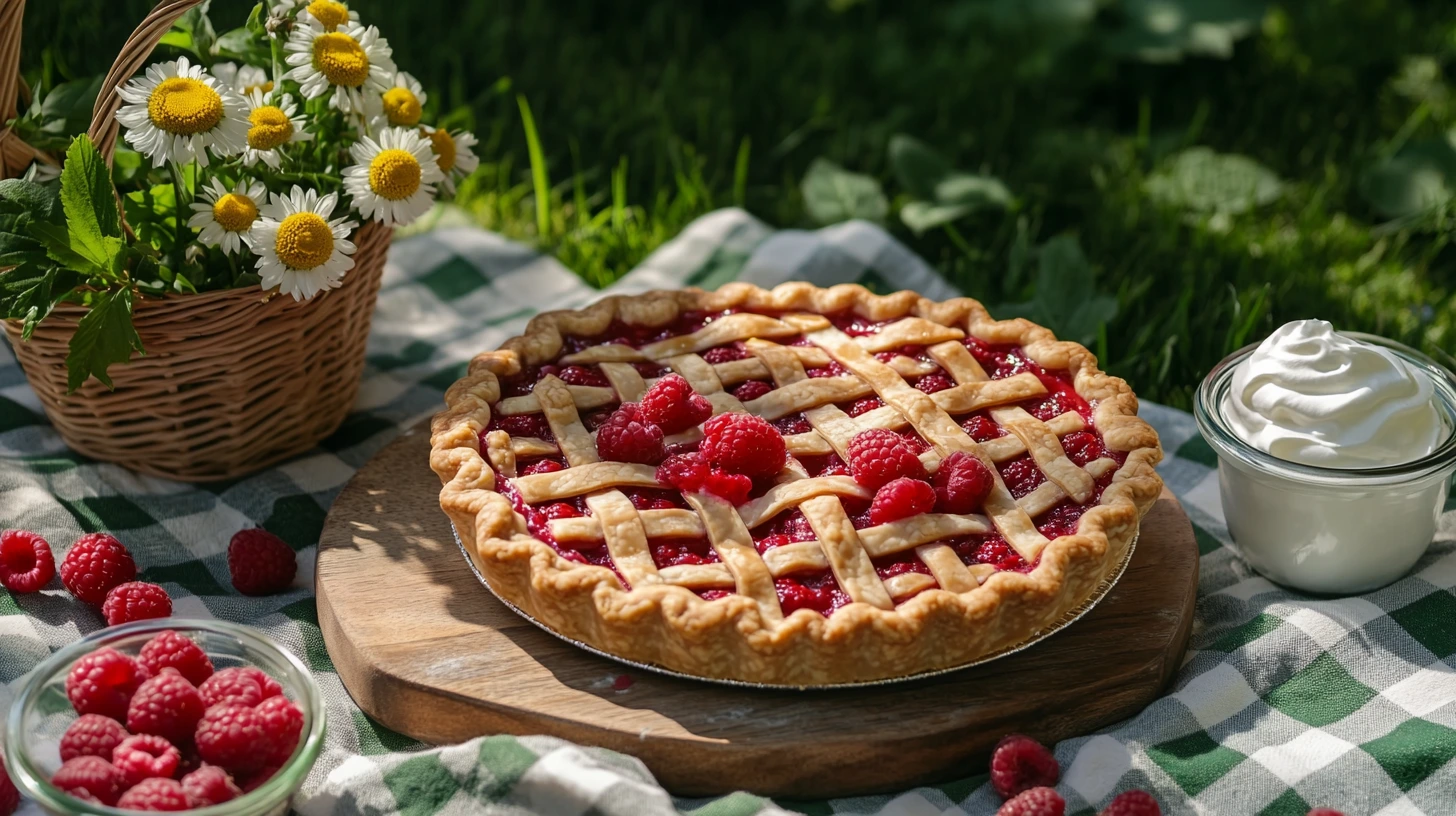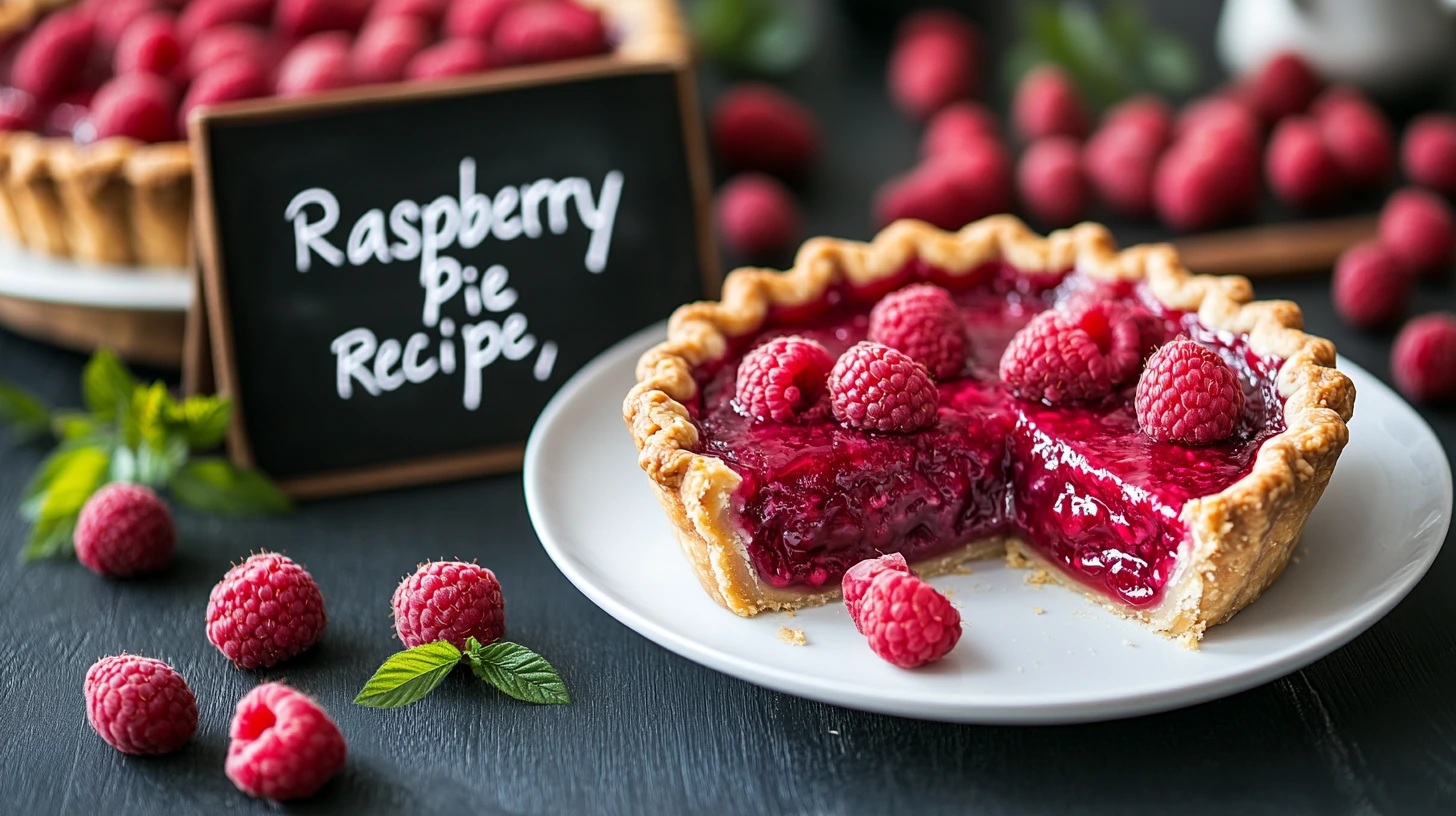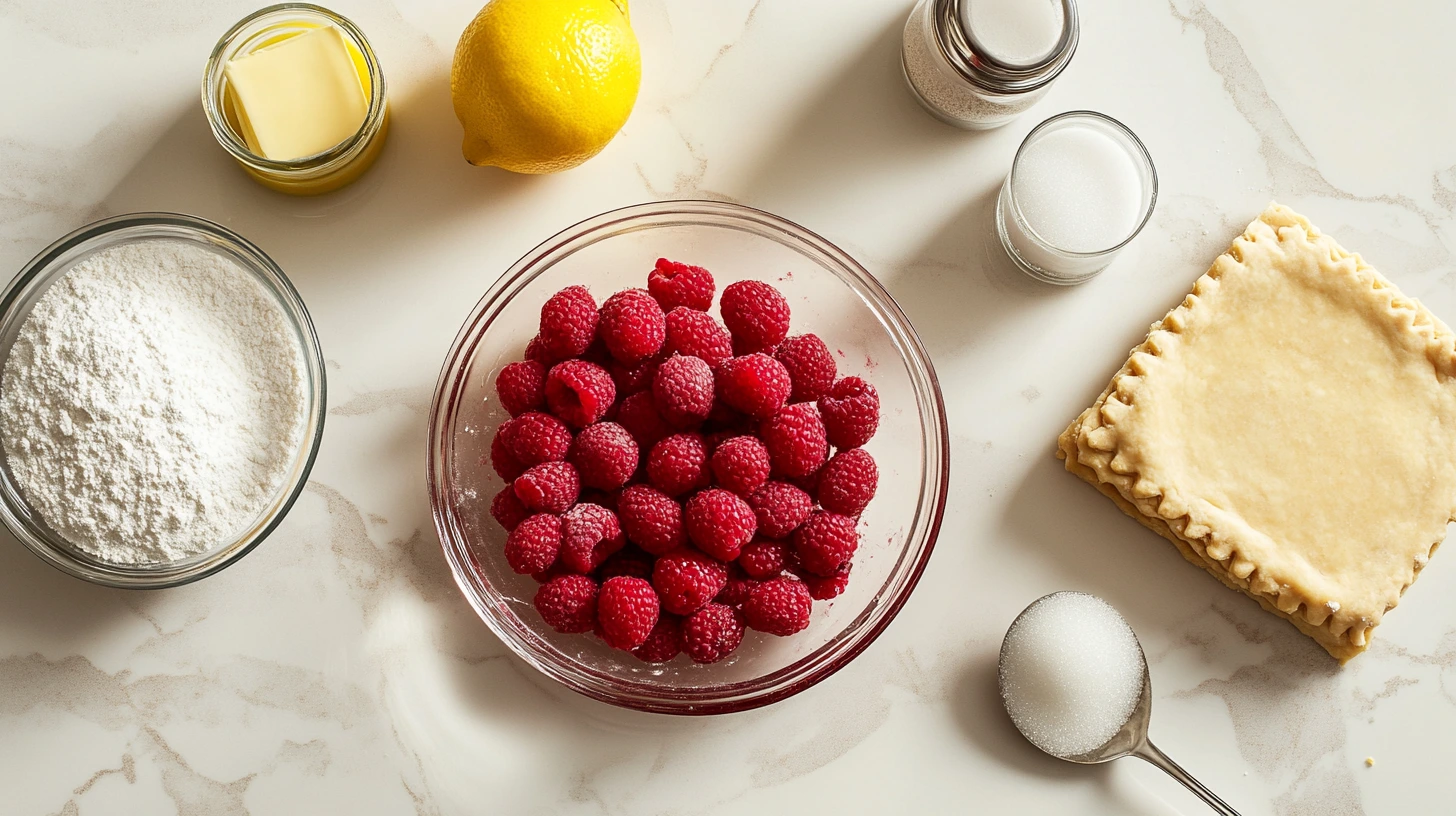
Table of Contents
Introduction to Raspberry Pie Recipe- What is Raspberry Pie?
A Raspberry Pie Recipe is a classic dessert made with a luscious filling of fresh or frozen raspberries encased in a flaky, buttery crust. This pie is celebrated for its balance of sweet and tart flavors, making it a favorite treat for summer gatherings, family dinners, and special occasions.
What Makes Raspberry Pie Recipe Unique?
- Flavor: The natural tartness of raspberries is perfectly complemented by sugar, creating a delightful balance.
- Texture: Combining juicy berries and a crisp, golden crust creates a satisfying bite.
- Visual Appeal: The deep red color of the raspberry filling makes this pie a stunning centerpiece.
Versatility of Raspberry Pie Recipe:
- Serving Options: Enjoy it warm with a scoop of vanilla ice cream, or serve it chilled for a refreshing treat.
- Customization: Enhance the flavor with hints of lemon, cinnamon, or even a sprinkle of nuts.
- Occasions: Ideal for everything from casual picnics to festive celebrations.
Key Ingredients for Raspberry Pie Recipe
When making a Raspberry Pie Recipe, the choice between fresh and frozen raspberries can influence your dessert’s flavor, texture, and overall outcome. Both options have advantages, so the decision depends on availability, seasonality, and personal preference.
Fresh Raspberries
- Pros:
- It is ideal for when raspberries are in season (summer months).
- Provide the best natural flavor and vibrant color.
- Require minimal preparation—no thawing needed.
- Cons:
- It’s more expensive, especially out of season.
- Delicate and prone to crushing, which can make handling tricky.
Frozen Raspberries
- Pros:
- Available year-round and usually more affordable.
- Convenient and easy to store.
- It has already been washed and is ready to use.
- Cons:
- It may release extra moisture during baking, requiring additional thickening agents like cornstarch or flour.
- It has a slightly less intense flavor compared to fresh berries.
Tips for Choosing Between Fresh and Frozen
- Seasonality: Opt for fresh raspberries when they peak during summer. Frozen is an excellent alternative for off-season baking.
- Recipe Adjustments: If using frozen raspberries, add more thickener (e.g., cornstarch) to prevent a runny filling.
- Availability: Fresh raspberries may not always be accessible or affordable, making frozen raspberries a reliable backup.
Ingredients
For the Pie Filling:
- 4 cups raspberries (fresh or frozen)
- 3/4 cup granulated sugar (adjust based on the sweetness of the berries)
- Three tablespoons cornstarch (or four tablespoons if using frozen raspberries)
- One tablespoon of fresh lemon juice
- 1/2 teaspoon vanilla extract (optional)
- Pinch of salt
For the Pie Crust:
- Two pie crusts (homemade or store-bought) for a 9-inch pie
- One egg (for egg wash)
- One tablespoon water (for egg wash)
- One tablespoon granulated sugar (for sprinkling on top, optional)
Instructions
1: Prepare the Filling
Preheat the oven to 375°F (190°C).
In a large bowl, combine raspberries, sugar, cornstarch, lemon juice, vanilla extract (if using), and a pinch of salt. Toss gently to coat the berries evenly. Set aside.
2: Assemble the Pie
Roll out the first pie crust and place it into a 9-inch pie dish, trimming any excess edges.
Pour the raspberry mixture into the prepared CrustCrust, spreading it evenly.
Roll out the second pie crust and place it over the filling. You can make a lattice pattern or leave it whole. If using a whole crust, cut a few slits in the top to allow steam to escape.
Seal the edges by crimping with a fork or pinching with your fingers.
3: Add Finishing Touches
Whisk together the egg and water in a small bowl to create an egg wash. Brush it over the top of the crust Crust.
Sprinkle with granulated sugar for a golden, sparkling finish.
4: Bake the Pie
Place the pie on a baking sheet to catch any drips.
Bake for 40-50 minutes until the Crust is golden brown and the filling is bubbling.
If the edges of the Crust begin to brown too quickly, cover them with aluminum foil.
5: Cool and Serve
Allow the pie to cool for at least 2 hours before slicing. This helps the filling set.
Serve warm or at room temperature with a scoop of vanilla ice cream or whipped cream.
Tips for Success
- Thickening the Filling: Adjust the amount of cornstarch depending on the juiciness of your raspberries.
- Frozen Raspberries: If using frozen raspberries, thaw them slightly and drain excess liquid before mixing.
- Storage: Store leftovers in the refrigerator for up to 3 days or freeze for extended storage.
Preparing the Raspberry Filling
A well-prepared filling is the heart of a delicious Raspberry Pie. Follow these steps to clean, prep, and flavor your raspberries for the perfect balance of sweetness and tartness.
How to Clean and Prep Raspberries
- Rinse Gently: Place fresh raspberries in a colander and rinse them under cool running water. Avoid soaking them to prevent water absorption.
- Drain Well: Let the berries sit in the colander for a few minutes to remove excess water. For extra care, gently pat them dry with a paper towel.
- Inspect for Quality: Remove any mushy, overripe, or spoiled berries before use. If using frozen raspberries, let them thaw slightly and drain excess liquid.
Adding Sugar, Cornstarch, and Flavoring
- Sugar: To sweeten the tartness, combine raspberries with granulated sugar. For a balanced flavor, use about 3/4 cup of sugar, adjusting based on the berries’ natural sweetness.
- Cornstarch: Add three tablespoons of cornstarch to thicken the filling. If using frozen raspberries, increase to 4 tablespoons to account for extra moisture.
- Flavor Enhancements:
- Lemon Juice: Add one tablespoon of fresh lemon juice to brighten the flavor.
- Vanilla Extract (Optional): Incorporate 1/2 teaspoon of vanilla extract for a subtle sweetness.
- Salt: A small pinch of salt enhances all the flavors in the filling.
Balancing Sweetness and Tartness
- Taste Test: Before assembling the pie, taste the filling mixture to ensure it suits your preference. Add more sugar for sweeter berries or lemon juice for a brighter, tart flavor.
- Adjust Gradually: Make small sugar and lemon juice adjustments to avoid overpowering the raspberries’ natural taste.
Making the Perfect Pie Crust

A buttery, flaky pie crust is the foundation of any great Raspberry Pie. Whether you make your own or use a store-bought option, Crust enhances the dessert’s overall flavor and texture.
Types of Crusts (Homemade vs. Store-Bought)
- Homemade Crust:
- Pros: It offers the best flavor, texture, and control over ingredients. With the proper technique, you can achieve a tender Crust Crust.
- The cons are that it requires time, effort, and skill to make from scratch and that it involves a few more ingredients.
- Best For Those who enjoy baking and want a more customized, fresh result.
- Essential Ingredients for Homemade Crust:
- All-purpose flour
- Cold butter
- Ice water
- A pinch of salt
- Optional: Sugar for sweet pies
- Store-Bought Crust:
- Pros: Quick, convenient, and saves time. Great for busy bakers or beginners.
- Cons: It may lack the same depth of flavor and texture as homemade.
- Best For Anyone looking to save time or for quick preparation without compromising too much on taste.
- Tip: Look for high-quality, all-butter, or butter-blend pie crusts for a better taste and flakiness.
Tips for a Buttery, Flaky Crust
- Use Cold Ingredients: Ensure your butter and water are cold. This helps create a flaky texture by preventing the butter from thoroughly blending into the flour. Cold butter forms little pockets of fat that melt during baking, creating a flaky crust.
- Don’t Overwork the Dough: Mix the dough until it is combined. Overworking the dough can lead to a tough, dense crust.
- Chill the Dough: After forming the dough into a disk, wrap it in plastic wrap and refrigerate it for at least 30 minutes. This relaxes the gluten and keeps the dough firm for easy rolling.
- Use a Light Hand When Rolling: Roll the dough evenly and avoid pressing too hard, which can compact the dough and reduce its flakiness.
- Add a Touch of Vinegar or Lemon Juice: A teaspoon of vinegar or lemon juice in the dough can help tenderizCrust Crust and create a lighter texture.
Pre-Baking the Crust for Stability
- Why Pre-Bake? Pre-baking (also known as blind baking) helps seCrust Crust, preventing it from becoming soggy when filled with wet fillings like the raspberry mixture.
- How to Pre-Bake:
- LineCrust Crust with parchment paper or foil.
- Add pie weights, dry beans, or rice to weigh it down and keep the Crust from puffing up.
- Bake at 375°F (190°C) for 15-20 minutes until the edges are lightly golden. Remove the weights and parchment, then bake for another 5-10 minutes to ensure the bottom is golden and crisp.
- For an Even Crust: If you’re worried about overbaking or uneven browning, crack It with a thin layer of egg wash (a beaten egg with a bit of water) before baking to help it brown beautifully.
Baking the Pie
Baking your Raspberry Pie to perfection is the final step that transforms your hard work into a delicious dessert. The key to success lies in the right oven temperature, proper rack placement, and careful attention to prevent common issues like a soggy bottom.
Optimal Oven Temperature and Rack Placement
- Oven Temperature: Preheat your oven to 375°F (190°C). This temperature ensures that the crust Crust bakes evenly, becoming golden and crisp while allowing the filling to bubble and thicken.
- Rack Placement: Place the pie on the middle rack of your oven. This helps the pie cook evenly from top to bottom. Avoid placing the pie too close to the top or bottom heating elements, which can cause uneven baking or burning.
Storage and Freezing Tips
If you have leftover Raspberry Pie or want to make it ahead, proper storage and freezing techniques can help maintain its freshness and flavor. Here are some helpful tips for storing and reheating your pie.
Storing Leftovers Properly
- Room Temperature: If you plan to eat the pie within a couple of days, store it at room temperature for up to 2 days. Cover it loosely with plastic wrap or foil to prevent drying.
- Refrigeration: For more extended storage, place the pie in the refrigerator. Cover it with plastic wrap or foil to prevent the Crust from going stale. Leftover pie will stay fresh for up to 3 days in the fridge.
- Avoid Plastic Wrap Directly on the Filling: If you cover the pie with plastic wrap, avoid placing it directly on the filling to prevent Crust from becoming soggy. Instead, use parchment paper or foil as a barrier.
Freezing the Pie for Future Use
- Freezing a Whole Pie: To freeze an entire pie, first ensure it is completely cooled. Then, cover the pie tightly with plastic wrap and aluminum foil to protect it from freezer burn. Label it with the date and freeze it for up to 3 months.
- Freezing Pie Slices: For individual servings, slice the pie and wrap each piece tightly in plastic wrap before placing them in a large freezer bag or airtight container. This makes it easy to defrost and enjoy a slice whenever you like.
- Pre-Baking for Freezing: You can also freeze the pie before baking. Assemble the pie, wrap it tightly, and freeze. When ready to bake, do not thaw the pie. Bake it from frozen, but add 10-15 minutes to the baking time to ensure the filling cooks thoroughly.
FAQs About Raspberry Pie Recipe
Here are answers to some common questions to help you bake the perfect Raspberry Pie Recipe every time:
Can I Use Frozen Raspberries?
Yes, you can use frozen raspberries in your Raspberry Pie. They work well, especially when fresh raspberries are out of season. However, there are a few things to keep in mind:
- Thawing: Allow the raspberries to thaw slightly and drain any excess liquid before mixing them into the filling. This will help prevent the filling from becoming too watery.
- Extra Thickening: Frozen raspberries release more moisture during baking, so adding more cornstarch or flour (about one extra tablespoon) is a good idea to ensure the filling thickens appropriately.
- Texture: The texture of the berries might be softer than fresh ones, but the flavor will still be delicious.
How Do I Prevent a Runny Filling?
A runny filling can be disappointing, but there are several steps to ensure your Raspberry Pie filling sets properly:
- Use Enough Thickener: Make sure to add enough cornstarch or flour (3 tablespoons of cornstarch or four tablespoons if using frozen raspberries). This helps absorb the moisture from the berries.
- Cook the Filling Before Baking: If you’re worried about the filling being too runny, briefly cook the raspberry filling on the stovetop to thicken it before adding it to the pie crust.
- Let the Pie Cool: Allow the pie to cool completely before slicing. The filling needs time to set and firm up, primarily if you’re serving it warm. Cutting it too soon may cause it to run.
What If My Crust Burns?
IfCrust Crust starts to burn before the filling is fully baked, don’t worry—there are ways to fix or prevent it:
- Cover the Edges: If the edges of the crust Crust are getting too dark too quickly, cover them with aluminum foil or a pie shield. This will protect the Crust from direct heat while allowing the rest of the pie to bake correctly.
- Oven Temperature: Ensure your oven is set to the correct temperature (375°F/190°C). If it’s too high a crust, Crust may cook too fast. You can lower the temperature by 10-15 degrees if needed.
- Check Early: Start checking your pie after about 30 minutes of baking. If the ICrust Crust is browning too much, cover the edges with foil and continue baking until the filling is bubbly and the Crust Crust is golden.
- Pre-BakCrust Crust Properly: When blind-baking, make sure to follow the steps carefully, using pie weights or dried beans to prevent puffing and burning.
Conclusion
Raspberry Pie is a delicious and timeless dessert that combines the perfect balance of tart, juicy raspberries, and a buttery, flaky crust. Whether you make it with fresh or frozen raspberries, the result is always a crowd-pleaser. With the proper techniques for preparing the filling, making the Crust, and baking to perfection, you can create a stunning pie that’s sure to impress.
By following the tips on storage, freezing, and reheating, you can enjoy this sweet treat for days to come. By making a few adjustments, you can even create a lighter version without compromising flavor.
This guide has provided all the essential information to make your raspberry pie a success, from preventing a soggy bottom to ensuring the filling sets perfectly. So go ahead and bake this delightful dessert—whether for a special occasion or a simple treat, it’s sure to be loved by all!
Try this recipe tonight and tag us @biscsweet on social media and follow us on Facebook.

